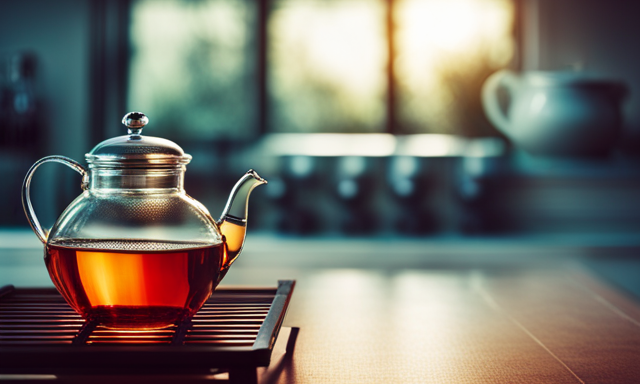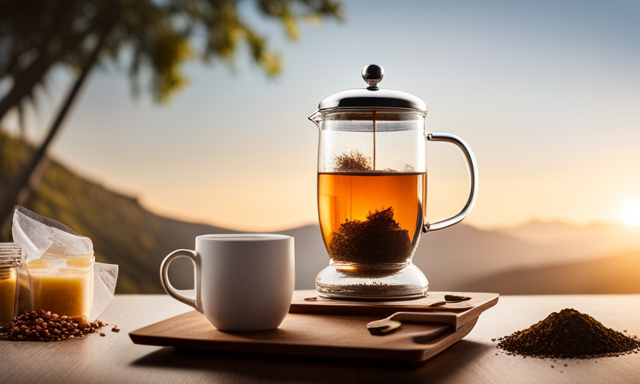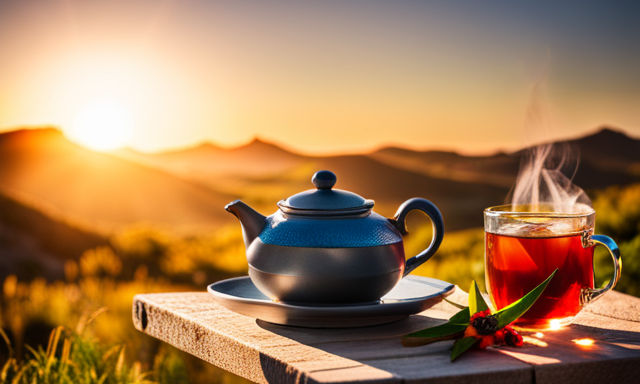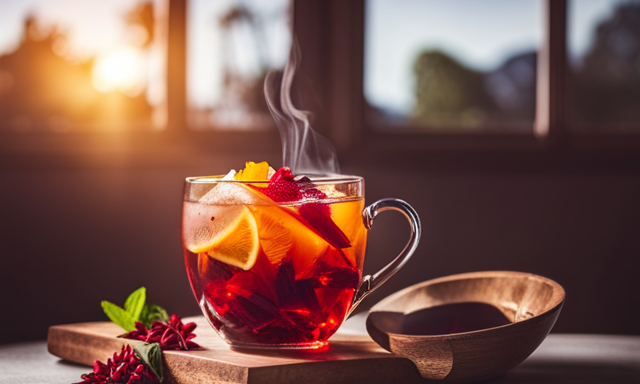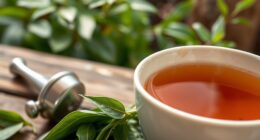Steeping a cup of rooibos tea is like unraveling a hidden treasure. As the delicate leaves dance in the hot water, they release a symphony of flavors and aromas that can transport you to a tranquil oasis.
But here’s the secret: the temperature at which you steep your rooibos tea can make all the difference in unlocking its true potential. In this article, I will guide you through the optimal temperature for steeping rooibos tea and show you how it can enhance your tea-drinking experience.
We’ll dive into the rich flavor profile of rooibos tea and explore how temperature impacts its aroma. I’ll also share some expert tips on how to achieve the perfect cup of rooibos tea by experimenting with different steeping temperatures.
And let’s not forget about the health benefits of this wonder tea – we’ll uncover how proper steeping can boost its potency.
So, grab your teapot and get ready to embark on a journey of tea-infused bliss.
Key Takeaways
- Recommended steeping temperature for rooibos tea is 200-212°F (93-100°C)
- Steep rooibos tea for 5-7 minutes
- Rooibos tea enhances the release of rich, earthy, and slightly sweet flavors
- Rooibos tea is often enjoyed as a hot beverage, but can also be served as iced tea
The Optimal Temperature for Steeping Rooibos Tea
To bring out the best flavors in your rooibos tea, you’ll want to steep it at the optimal temperature. Rooibos tea is known for its rich and earthy taste, and steeping it at the right temperature is crucial to unlock its full potential.
The optimal steeping temperature for rooibos tea is around 200°F (93°C). This temperature allows the tea leaves to release their flavors without becoming bitter or astringent.
When it comes to steeping vessel options, you have a few choices. You can use a teapot, a teacup with an infuser, or a tea ball. Each option has its advantages, but the key is to ensure that the tea leaves have enough space to expand and infuse properly.
Understanding the flavor profile of rooibos tea is essential to fully appreciate this unique beverage. From its natural sweetness to its subtle nutty undertones, rooibos tea offers a delightful and comforting experience.
Understanding the Flavor Profile of Rooibos Tea
Discover the unique taste experience of rooibos tea by exploring its rich and distinct flavor profile. Rooibos tea is known for its natural sweetness and smooth, earthy notes. To fully unlock the health benefits and enhance its flavor profile, it’s important to understand its key characteristics:
1) Sweetness: Rooibos tea has a naturally sweet taste, reminiscent of honey or vanilla.
2) Earthiness: This tea carries a gentle, earthy flavor, similar to that of a herbal infusion.
3) Nuttiness: Rooibos tea often exhibits a subtle nutty undertone, adding depth to its overall flavor.
4) Fruity undertones: Some varieties of rooibos tea showcase fruity notes, such as citrus or berry, which provide a refreshing twist.
Understanding these flavor elements allows you to appreciate the true essence of rooibos tea.
Transitioning into the subsequent section, let’s now explore the impact of temperature on rooibos tea’s aroma.
The Impact of Temperature on Rooibos Tea’s Aroma
Experience a tantalizing aroma that evolves with every sip as you explore the impact of temperature on rooibos tea’s flavor. Temperature plays a crucial role in the brewing process of this beloved herbal infusion, affecting both the scent and taste of the final cup.
When steeped at a lower temperature, around 180°F (82°C), rooibos tea offers a delicate and floral aroma, with notes of honey and vanilla. As the temperature increases to around 212°F (100°C), the aroma intensifies, releasing a rich and robust scent that hints at caramel and earthy undertones. The hotter the water, the stronger the aroma becomes, providing a more pronounced sensory experience.
So, by adjusting the temperature, you can unlock a spectrum of fragrances in your rooibos tea.
Now, let’s delve into the subsequent section to discover the perfect steeping tips for a truly exquisite cup of rooibos tea.
Steeping Tips for the Perfect Cup of Rooibos Tea
Get ready to brew a cup of rooibos tea that’s as perfect as a blooming flower with these steeping tips. Steeping techniques play a crucial role in extracting the full flavor and aroma of rooibos tea.
To achieve the best results, start by using freshly boiled water. Rooibos tea is quite forgiving when it comes to steeping time, but I recommend letting it steep for at least five minutes to ensure a robust flavor. However, if you prefer a milder taste, you can reduce the steeping time to three minutes.
As for temperature, rooibos tea can be steeped at a range of temperatures, but I find that using water around 200°F (93°C) brings out the best flavor variations. Experimenting with different steeping temperatures allows you to discover your preferred taste profile.
Transitioning to the next section, let’s explore the impact of temperature on rooibos tea’s aroma.
Experimenting with Different Steeping Temperatures
By varying the heat of the water, you can unlock a symphony of flavors in your cup of rooibos tea. Experimenting with different steeping temperatures allows you to explore the full potential of this delicious beverage.
Here are three temperature options to try:
-
185°F (85°C): This temperature brings out the natural sweetness of rooibos tea, enhancing its honey-like notes and creating a smooth and mellow flavor profile.
-
200°F (93°C): Steeping rooibos tea at this temperature intensifies its earthy undertones, resulting in a richer and bolder taste.
-
212°F (100°C): For those who prefer a robust and full-bodied cup of rooibos tea, boiling water is the way to go. This high temperature extracts the tea’s flavors more rapidly, resulting in a stronger brew.
By experimenting with these different steeping temperatures, you can discover the perfect balance of flavors that suits your taste buds.
Next, let’s explore how proper steeping techniques can unlock the health benefits of rooibos tea.
Unlocking the Health Benefits of Rooibos Tea through Proper Steeping
Steeping rooibos tea correctly can maximize its health benefits, with studies showing that regular consumption may potentially lower the risk of chronic diseases such as heart disease and diabetes. When it comes to steeping techniques, it’s important to pay attention to the temperature of the water.
The ideal temperature for steeping rooibos tea is 203°F (95°C). This allows the leaves to release their beneficial compounds, including antioxidants and polyphenols, without extracting any bitter flavors. Steeping at a higher temperature can result in a more astringent taste, while steeping at a lower temperature may not fully extract the tea’s health-promoting properties.
By steeping rooibos tea at the optimal temperature, you can unlock its full potential for improving your overall well-being.
Moving forward to the next section, let’s explore how to avoid common mistakes in rooibos tea steeping and ensure a perfect cup every time.
Avoiding Common Mistakes in Rooibos Tea Steeping
When it comes to unlocking the health benefits of Rooibos tea, proper steeping is crucial. However, there are some common mistakes that should be avoided to ensure the best cup of tea.
Firstly, oversteeping can result in a bitter taste and diminish the delicate flavors of Rooibos tea. It’s important to follow the recommended steeping time, usually around 5-7 minutes, depending on the variety.
Secondly, understanding the different Rooibos tea varieties is essential for a successful steeping process. Green Rooibos requires a lower temperature of around 175°F, while fermented Rooibos can be steeped at a higher temperature of 200°F.
Lastly, herbal Rooibos teas can be steeped at boiling point, around 212°F, to extract their full flavor. By avoiding these common mistakes and understanding the varieties, you can enhance your Rooibos tea experience with temperature control, ensuring a perfect cup every time.
Enhancing Your Rooibos Tea Experience with Temperature Control
Experience the full flavor and exquisite taste of Rooibos tea by carefully controlling the temperature. Temperature control plays a vital role in enhancing your Rooibos tea experience. By adjusting the temperature, you can unlock the full potential of its flavor profiles.
The benefits of temperature control are twofold. Firstly, it allows you to extract the optimal flavors from the tea leaves without overpowering them. Secondly, it ensures that the tea remains smooth and balanced, avoiding any bitter or astringent taste.
For Rooibos tea, it’s recommended to steep it at a temperature between 200-212°F (93-100°C) for 5-7 minutes. This temperature range allows the tea to release its rich, earthy, and slightly sweet flavors, resulting in a truly satisfying cup of Rooibos tea.
Frequently Asked Questions
How long should I steep rooibos tea?
To prepare rooibos tea, steep it for 5-7 minutes. This allows the flavors to fully develop. Rooibos tea is known for its numerous health benefits, including being rich in antioxidants and aiding in digestion.
Can I use boiling water to steep rooibos tea?
Yes, you can use boiling water to steep rooibos tea, but using cold water is recommended. Steeping in cold water enhances the flavor and benefits of rooibos tea, resulting in a more refreshing and nutrient-rich brew.
Should I cover the tea while it steeps?
To enhance the flavor of your rooibos tea, it is recommended to cover it while steeping. For a perfect brew, I suggest using a teapot and avoiding adding milk or sugar to maintain its natural taste.
Can I reuse the rooibos tea leaves for a second steep?
Yes, you can reuse rooibos tea leaves for a second steep. This is a great way to get the most out of your tea and maximize its health benefits. The second steeping can still be flavorful and enjoyable.
Is there a recommended water-to-tea ratio for steeping rooibos tea?
For steeping rooibos tea, it is important to use a water-to-tea ratio of 1:1.5. The recommended water temperature is 200°F. This ensures optimal flavor extraction and a rich, aromatic cup of tea.
Conclusion
In conclusion, finding the perfect temperature to steep rooibos tea is crucial in unlocking its full potential. By understanding the flavor profile and aroma of this unique tea, we can experiment with different temperatures to enhance our tea-drinking experience.
By properly steeping rooibos tea, we can also maximize its health benefits. So, let’s not make common mistakes and instead, use temperature control to elevate our enjoyment of this delightful beverage.
Cheers to a perfectly steeped cup of rooibos tea!

